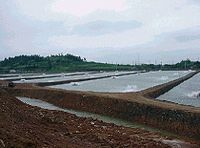
Photo from wikipedia
We investigated the population structure, sex ratio, growth parameters, longevity and natural mortality (M) of a hololimnetic population of the Amazon River prawn Macrobrachium amazonicum that presents different morphotypes. Sampling… Click to show full abstract
We investigated the population structure, sex ratio, growth parameters, longevity and natural mortality (M) of a hololimnetic population of the Amazon River prawn Macrobrachium amazonicum that presents different morphotypes. Sampling was performed monthly from May 2017 to April 2018 in a water reservoir in the municipality of Severinia, Sao Paulo, southeast Brazil. Juveniles, ovigerous females (OF) and males (except the morphotypes GC2) were more abundant in the dry season. The overall and seasonal sex ratio leaned toward males. Males were also more abundant in the larger size classes. Growth parameters for males and females were CL∞ = 19.98 mm and 16.94 mm, k = 4.42 year−1 and 3.94 year−1, t0 = -0.3762 and 0.0628, respectively. Longevity was 1.04 years for males and 1.17 years for females, and M was 4.43 year−1 for males and 3.94 year−1 for females. The OF sampled presented smaller sizes in comparison to those registered in the literature, which may be because they reach sexual maturity sooner than in other localities. Males attained larger asymptotic sizes than females; however, their increased growth rate resulted in lower longevity and higher M. High M values among larger males can occur due to disputes over territory, food, and females, while smaller males are often cannibalized. Both sexes presented low longevity, intense growth rates and small asymptotic sizes in comparison to those registered in the literature, which is likely due to high instability in the system caused by environmental variations and anthropic influences.
Journal Title: Aquatic Ecology
Year Published: 2021
Link to full text (if available)
Share on Social Media: Sign Up to like & get
recommendations!